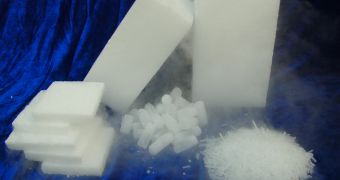Dry ice is basically frozen carbon dioxide. It might not sound like much but dry ice bears some unique properties that make it ideal for certain cooling applications. First of all, as its name says, it's dry, meaning that unlike other ices, such as frozen water, it does not go through a liquid state when heated. More precisely, when frozen, carbon dioxide breaks down, the process being called sublimation, a transformation from the solid state directly into the gaseous state.
Carbon dioxide freezes at normal atmospheric pressure at a temperature of minus 78.5 degrees Celsius. In combination with the sublimation property, this temperature makes dry ice great for refrigeration purposes, especially when dealing with moisture sensitive cargo that needs to be transported over great distances. In case the refrigeration system of the vehicle carrying the respective cargo malfunctions, dry ice would melt without leaving behind messy liquids as with any other ices.
Most of the time, liquid nitrogen is preferred over dry ice, but the temperature required to bring nitrogen to a liquid state under normal atmospheric pressure is nearly three times higher than that of dry ice, meaning minus 196 degrees Celsius. Alternatively, nitrogen cannot be brought to a solid state under normal atmospheric pressure because the phase diagram of the substance cannot allow that.
In order to understand this you would need to remember a rather more familiar phenomenon. Physics says that water freezes at zero degrees Celsius and boils at one hundred degrees at sea level - Earth's atmospheric pressure is measured at sea level. However, if on a mountain one may observe that the boiling temperature of water drops, it's because atmospheric pressure decreases with altitude.
Liquid carbon dioxide can only be obtained through compression. One can never turn carbon dioxide to a liquid state by lowering the temperature under normal pressure. You might have observed that carbon dioxide fire extinguishers, containing carbon dioxide in a liquid state, eject dry ice when used. This is because the phase transformation from liquid to gaseous state is a heat absorbent reaction.
The liquid leaves the container at high pressure at normal temperature. However, as it exits into the atmosphere, the liquid turns to gas with a temperature lower than the freezing point. The gas immediately condenses into a solid state, making it appear as if carbon-dioxide snow exits the nozzle.
Dry ice is usually harmless, but manipulating it requires the use of protective gear - heavy gloves - and special precautions. The low temperature could easily damage your skin or any other part of the body it touches. When working with dry ice in closed environments, ventilation is imperative. The normal concentration of carbon dioxide in Earth's atmosphere is only 0.035 percent. Anything above 5 percent renders carbon dioxide toxic and even lethal in the cases of prolonged exposure. Remember these two rules and everything will be just fine.

 14 DAY TRIAL //
14 DAY TRIAL //